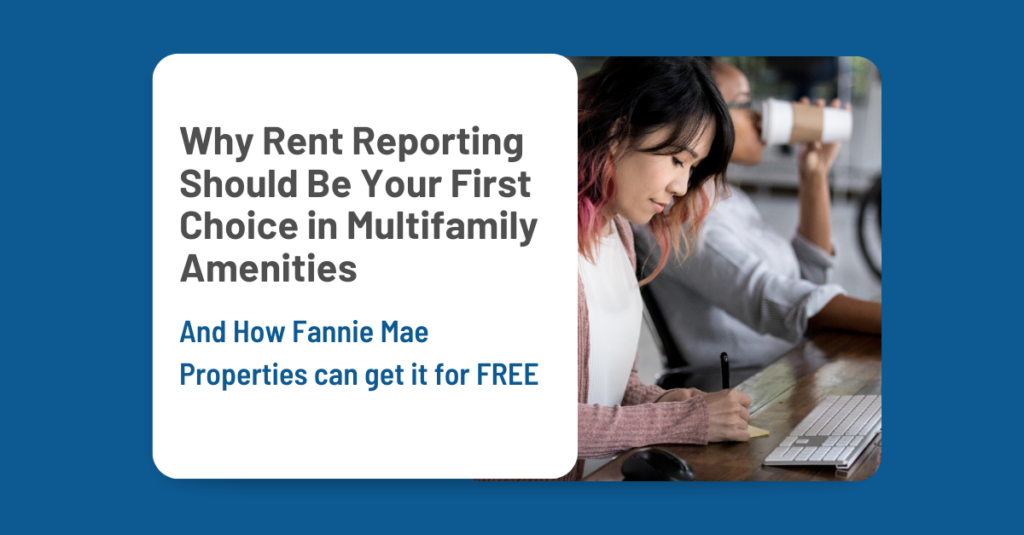Rent Reporting is not an entirely new concept in the world of FinTech, yet the bridge between residents who want it and properties who are offering it still exists – and there’s a lot of room yet to fill.
As of February 2023, The Federal Housing Finance Agency (FHFA) has announced that it has started the implementation process of including rent reporting into FICO 10T and VantageScore 4.0 for use by Fannie Mae and Freddie Mac. Put simply – now when you pay your rent, utilities, and phone payments, the new models will include these as part of your credit building history. The days of not receiving any benefits for paying your rent are about to be over. It comes at a peak time when renting now makes up over 34% of American households, equating to roughly 44 million people.
As multifamily operators continue to level the playing field with love-to-have amenities including pickleball courts, rock-climbing walls, saunas, and doggy daycares, financial services remain an underserved need-to-have for so many.
Ramifications of invisible and poor credit
In student housing communities, where young adults are trying to establish rent for their first time ever, rent reporting comes at a high value, where they can go from unscorable to scorable in a matter of months. In addition, many don’t realize just how much a bad credit score can implicate everything from higher car loans, to more expensive premiums, difficulty starting a business or applying for a job, and higher mortgage rates; the list of challenges post to poor credit goes on.
From the property management perspective, rent reporting is a win-win not just for creating resident value, but driving NOI. Having a rent reporting amenity not only provides you with a competitive edge and increases your resident retention, but helps reduce delinquencies, and in some rent reporting enrollment models, can even yield as high as thousands of dollars in MRR back to your properties.
How many residents are interested in rent reporting as an amenity?
In a recent TransUnion survey, 77% of 2,039 renters surveyed said they would be more likely to pay rent on time if they knew their rent payment history would be reported to credit reporting agencies. Furthermore, over half of the same respondents are aware that their payments can be reported and are at least “somewhat interested” in rent reporting. For even younger Gen Z respondents, 60% said they were not only aware, but also interested in having their rent payments reported.
Setting a standard apart from the crowd with meaningful ESG initiatives
In an age where leasing remains more competitive than ever, rent reporting offers a viable ready-to-roll alternative to other amenities that are costly and can take months, even years to implement. As Manjit Sohal says it best from Multifamily Insiders, “Not all amenities need to be something physical, and one of the most powerful benefits communities can provide residents comes through reporting on-time rent payments to credit bureaus…And because this financial amenity is not widespread throughout the industry yet, it can provide a community with a significant competitive advantage”.
Not only is financial wellness an underplayed amenity in the multifamily world, but it helps fill an ESG void as multifamily operators strive to incorporate values into their playbooks, with 96% of S&P 500 companies now including ESG efforts into their regular reporting. Catherine Lucchesi, Director of ESG at Comunidad Partners, discusses the significance ESG-related amenities such as homework help, virtual health care, and credit-building have had for their portfolio. According to Lucchesi, Comunidad communities utilizing these types of amenities have a retention rate of nearly 68%—much higher than the national average of 57%.
Getting started with financial wellness amenities in your communities today
So if rent reporting has caught your interest up to this point, where do you begin? There are several existing rent reporting options available in the marketplace so shopping around can cause some decision fatigue. For our purposes, we’d recommend a program that has the minimum following qualifications:
- Flexible enrollment options that accommodate your property (see Fannie Mae options below!)
- A track record of long-term success
- Seamless integrations to pair with your systems already in place
- Data furnishing curated from the Rent Reporting provider, and not on you
- Extensive offerings outside of rent reporting included
***Fannie Mae properties Can Participate in Rent Reporting at No Cost!
As part of the Positive Rent Payment Pilot Program, Fannie Mae launched an initiative in the Fall of 2022 to partner exclusively with selected vendors to make rent reporting more accessible across multifamily nationwide. As part of the selected Pilot program, properties with a Fannie Mae loan with no other rent reporting programs in place can have access to 1 year of free unlimited access to rent reporting with selected vendors. With Rent Dynamics, rent reporting with RentPlus also includes a full suite of other financial services at no cost to properties or to residents.
If you made it this far, we hope you’re getting excited about the concept of offering rent reporting as an amenity for your community. But you might still have to get your C-suite on board. We’ve put together a quick guide to help you pitch RentPlus as an amenity to your C-Suite just for this case. Submit your email below to download it today!

